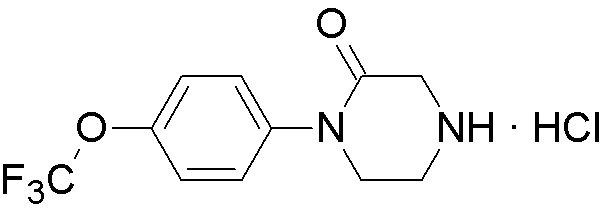1-(4-(Trifluoromethoxy)phenyl)piperazin-2-one hydrochloride is widely utilized in research focused on:
- Pharmaceutical Development: This compound serves as a key intermediate in the synthesis of various pharmaceuticals, particularly in the development of medications targeting neurological disorders.
- Neuropharmacology: It is used in studies to understand the mechanisms of action of drugs affecting the central nervous system, helping researchers develop more effective treatments.
- Analytical Chemistry: The compound is employed as a reference standard in analytical methods, ensuring accurate quantification of similar compounds in complex mixtures.
- Material Science: Its unique properties make it suitable for developing advanced materials, particularly in coatings and polymers that require enhanced chemical resistance.
- Biological Research: Researchers utilize this compound in various biological assays to evaluate its effects on cell signaling pathways, contributing to the understanding of cellular processes.
General Information
Properties
Safety and Regulations
Applications
1-(4-(Trifluoromethoxy)phenyl)piperazin-2-one hydrochloride is widely utilized in research focused on:
- Pharmaceutical Development: This compound serves as a key intermediate in the synthesis of various pharmaceuticals, particularly in the development of medications targeting neurological disorders.
- Neuropharmacology: It is used in studies to understand the mechanisms of action of drugs affecting the central nervous system, helping researchers develop more effective treatments.
- Analytical Chemistry: The compound is employed as a reference standard in analytical methods, ensuring accurate quantification of similar compounds in complex mixtures.
- Material Science: Its unique properties make it suitable for developing advanced materials, particularly in coatings and polymers that require enhanced chemical resistance.
- Biological Research: Researchers utilize this compound in various biological assays to evaluate its effects on cell signaling pathways, contributing to the understanding of cellular processes.
Documents
Safety Data Sheets (SDS)
The SDS provides comprehensive safety information on handling, storage, and disposal of the product.
Product Specification (PS)
The PS provides a comprehensive breakdown of the product’s properties, including chemical composition, physical state, purity, and storage requirements. It also details acceptable quality ranges and the product's intended applications.
Certificates of Analysis (COA)
Search for Certificates of Analysis (COA) by entering the products Lot Number. Lot and Batch Numbers can be found on a product’s label following the words ‘Lot’ or ‘Batch’.
*Catalog Number
*Lot Number
Certificates Of Origin (COO)
This COO confirms the country where the product was manufactured, and also details the materials and components used in it and whether it is derived from natural, synthetic, or other specific sources. This certificate may be required for customs, trade, and regulatory compliance.
*Catalog Number
*Lot Number
Safety Data Sheets (SDS)
The SDS provides comprehensive safety information on handling, storage, and disposal of the product.
DownloadProduct Specification (PS)
The PS provides a comprehensive breakdown of the product’s properties, including chemical composition, physical state, purity, and storage requirements. It also details acceptable quality ranges and the product's intended applications.
DownloadCertificates of Analysis (COA)
Search for Certificates of Analysis (COA) by entering the products Lot Number. Lot and Batch Numbers can be found on a product’s label following the words ‘Lot’ or ‘Batch’.
*Catalog Number
*Lot Number
Certificates Of Origin (COO)
This COO confirms the country where the product was manufactured, and also details the materials and components used in it and whether it is derived from natural, synthetic, or other specific sources. This certificate may be required for customs, trade, and regulatory compliance.

